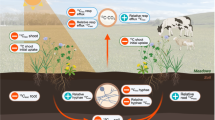Abstract
Seasonalvariation in leaf nitrogen of mature green and senescent leaves and nitrogenresorption efficiency in three plants (Spartina maritima, Halimioneportulacoides and Arthrocnemum perenne) of aTagus estuary salt marsh are reported. Total nitrogen concentrations in greenand senescent leaves were higher during winter (December and March). Soilinorganic nitrogen availability showed an opposite pattern with higherconcentrations during summer (June and September) when total leaf biomass washigher. Nitrogen resorption efficiency ranged between 31 and 76% andH. portulacoides was the plant that better minimizednitrogen loss by this process. Nitrogen resorption occurred mainly from thesoluble protein pool, although other fractions must have been broken down duringthe resorption process. No significant seasonal variation in nitrogen resorptionefficiency and no relation to leaf total nitrogen or soil nitrogen availabilitywere found. This suggests that the efficiency of the resorption process is notdetermined by the plant nitrogen status nor by the availability of the nutrientin the soil. Nevertheless, resorption from senescing leaves may play animportant role in the nitrogen dynamics of salt marsh plants and reduce thenitrogen requirements for plant growth.
Similar content being viewed by others
References
Aerts R. 1996. Nutrient resorption from senescing leaves of perennials: are there general patterns? Journal of Ecology 84: 597–608.
Bradford M.M. 1976. A rapid and sensitive method for the quantitation of microgram quantities of protein utilizing the principle of protein-dye binding. Analytical Biochemistry 72: 248–254.
Buchanan-Wollaston V. 1997. The molecular biology of leaf senescence. Journal of Experimental Botany 48: 181–199.
Buresh R.J., DeLaune R.D. and Patrick W.H. 1980. Nitrogen and phosphorus distribution and utilization by Spartina alterniflora in a Louisiana Gulf Coast marsh. Estuaries 3: 111–121.
Cartaxana P., Caçador I., Vale C., Falcão M. and Catarino F. 1999. Seasonal variation of inorganic nitrogen and net mineralization in a salt marsh ecosystem. Mangroves and Salt Marshes 3: 127–134.
Chapin F.S. 1980. The mineral nutrition of wild plants. Annual Review of Ecology and Systematics 11: 233–260.
Chapin F.S. and Kedrowski R.A. 1983. Seasonal changes in nitrogen and phosphorus fractions and autumn retranslocation in evergreen and deciduous taiga trees. Ecology 64: 376–391.
Chapin F.S. and Moilanen L. 1991. Nutritional controls over nitrogen and phosphorus resorption from Alaskan birch leaves. Ecology 72: 709–715.
Clark F.E. 1977. Internal cycling of 15N in shortgrass prairie. Ecology 58: 1322–1333.
Del Arco J.M., Escudero A. and Garrido M.V. 1991. Effects of site characteristics on nitrogen translocation from senescing leaves. Ecology 72: 701–708.
Evans J.R. 1983. Photosynthesis and nitrogen partitioning in leaves of Triticum aestivum and related species.
Hopkinson C.S. and Schubauer J.P. 1984. Static and dynamic aspects of nitrogen cycling in the salt marsh graminoid Spartina alterniflora. Ecology 65: 961–969.
Jonasson S. and Chapin F.S. 1985. Significance of sequential leaf development for nutrient balance in the cottonsedge Eriophorum vaginatum L. Oecologia 67: 511–517.
Kang S.M. and Titus J.S. 1980. Quantitative and qualitative changes in nitrogenous compounds in senescing leaf and bark tissue of the apple. Physiologia Plantarum 50: 285–290.
Killinbeck K.T. 1996. Nutrients in senesced leaves: keys to the search for potential resorption and resorption proficiency. Ecology 77: 1716–1727.
Ku M.S.B., Schmitt M.R. and Edwards G.E. 1979. Quantitative determination of RUBP carboxylase/oxygenase protein in leaves of C3 and C4 plants. Journal of Experimental Botany 30: 89–98.
Lajtha K. 1987. Nutrient resorption efficiency and the response to phosphorus fertilization in the desert shrub Larrea tridentata (DC) Cov. Biogeochemistry 4: 265–276.
Lajtha K. and Whitford W.G. 1989. The effect of water and nitrogen amendments on photosynthesis, leaf demography, and resource-use efficiency in Larrea tridentata, a desert evergreen shrub. Oecologia 80: 341–348.
Mendelssohn I.A. 1979. The influence of nitrogen level, form and application method on the growth response of Spartina alterniflora in North Carolina. Estuaries 2: 106–112.
Millard P. and Thomson C.M. 1989. The effect of the autumn senescence of leaves on the internal cycling of nitrogen for the spring growth of apple trees. Journal of Experimental Botany 40: 1285–1289.
Osgood D.T. and Zieman J.C. 1993. Factors controlling above-ground Spartina alterniflora (smooth cordgrass) tissue element composition and production in different-age barrier island marshes. Estuaries 16: 815–826.
Pugnaire F.I. and Chapin F.S. 1992. Environmental and physiological factors governing nutrient resorption efficiency in barley. Oecologia 90: 120–126.
Pugnaire F.I. and Chapin F.S. 1993. Controls over nutrient resorption from leaves of evergreen Mediterranean species. Ecology 74: 124–129.
Shaver G.R. and Melillo J.M. 1984. Nutrient budgets of marsh plants: efficiency concepts and relation to availability. Ecology 65: 1491–1510.
Sokal R.R. and Rohlf F.J. 1995. Biometry. Freeman, San Francisco.
Turner J. 1977. Effects of nitrogen availability on nitrogen cycling in a Douglas-fir stand. Forest Science 23: 307–316.
Vitousek P. 1982. Nutrient cycling and nutrient use efficiency. American Naturalist 119: 553–572.
White D.S. and Howes B.L. 1994a. Translocation, remineralization, and turnover of nitrogen in the roots and rhizomes of Spartina alterniflora (Gramineae). American Journal of Botany 81: 1225–1234.
White D.S. and Howes B.L. 1994b. Long-term 15N-nitrogen retention in the vegetated sediments of a New England salt marsh. Limnology and Oceanography 39: 1878–1892.
Woodwell G.M. 1974. Variation in the nutrient content of leaves of Quercus alba, Quercus coccinea, and Pinus rigida in the Brookhaven Forest from bud-break to abcission. American Journal of Botany 61: 749–753.
Author information
Authors and Affiliations
Rights and permissions
About this article
Cite this article
Cartaxana, P., Catarino, F. Nitrogen resorption from senescing leaves of three salt marsh plant species. Plant Ecology 159, 95–102 (2002). https://doi.org/10.1023/A:1015595430010
Issue Date:
DOI: https://doi.org/10.1023/A:1015595430010




